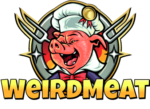Head cheese is a specialty cold cut found in many corner butcher shops across the United States. It’s made from the boiled scraps of pig’s head and feet, spread on crackers or used in po’ boy sandwiches with creole mustard.
Unlike meat jellies, which are made from commercial gelatin, head cheese uses a naturally-produced broth. After the bones have been boiled down, their connective tissues release enough gelatin to congeal when it’s cool.
Overview of Head Cheese as a Food Source
Head cheese is an organ sausage or meat jelly that is typically served cold or at room temperature. It is made with pork trimmings, onions, vinegar and gelatin.
Traditionally, it is made from the head of a pig or calf. However, it can also be made with other animals’ heads, including cows and sheep.
It is a meat jelly that can be formed into a sausage or served as a terrine dish. It should be served chilled to prevent the gelatin from melting.
Traditionally, it includes different cuts of the head meat, including the jowls, skin, tongue and ears. Occasionally, it may include the feet and heart as well.
Culinary Uses and Traditional Dishes
Head Cheese is a European cold cut terrine or meat jelly made from the head of a calf or pig (less commonly a sheep or cow).
This dish was popularized in Middle Ages Europe, when people needed to use as much of the animal as possible for food. It was originally made from chopped and boiled pig’s head meat, but nowadays it can include edible parts of the tongue or feet.
Making head cheese involves boiling bits of pig meat that come from the head, feet and other organs to extract the collagen. This helps to give the resulting mixture a gelatinous binding.
Availability and Market Trends
Head cheese, also known as brawn, is a European meat jelly made from the head of a pig or calf. It resembles more of a large sausage or cold cut terrine than dairy cheese.
It’s popular all over Europe and in the United States and Canada. It’s commonly found in European delis and can be sliced up for sandwiches or served as a charcuterie platter.
The meat in head cheese usually comes from the pig’s head (including eyes, ears, and brain), although feet and tongue are sometimes included. It is set in aspic and can be flavored with onion, black pepper, allspice, bay leaf, salt, and vinegar.
Health Benefits and Concerns
Head Cheese can be a great source of protein and fiber, but there are a few concerns related to its consumption. For one, it may contain Listeria monocytogenes, which causes a serious foodborne illness.
The risk of this infection can be higher for people with chronic illnesses, the elderly, and those who are pregnant. It’s important to ensure that you buy only certified organic Head Cheese and that it’s not contaminated with vinegar or wine.
It is also important to note that dairy products are a major source of saturated fat, which is linked to heart disease and type 2 diabetes. It is a good idea to make sure that you get enough unsaturated fats, like olive oil and nuts in your diet, as well.
Sustainability Issues
One of the world’s biggest challenges is feeding everyone in a sustainable way. Unfortunately, meat production can have huge impacts on the environment – including greenhouse gas emissions, agricultural land and water use.
When it comes to cheese, a typical serving (about 30 grams) of cheese per day can create 201 kg of CO2 equivalent per year. That’s four times as much as eating nuts or tofu, which are both considered carbon negative foods.
Fortunately, it is possible to minimize the environmental impact of cheese by selecting low-fat and soft varieties such as mozzarella, feta or camembert. This can help reduce emissions and save the planet. Ultimately, it’s up to us as consumers to make smart decisions about the food we eat. We can also encourage farmers to adopt more sustainable practices that protect the environment.

